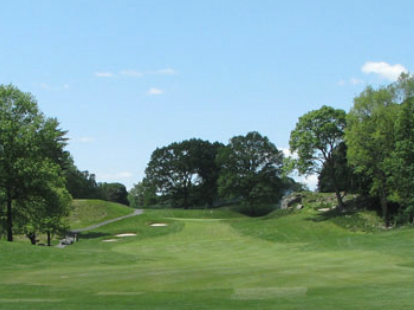Apawamis Club, The

The Apawamis Club is a Private, 18 hole golf course located in Rye, New York.
Apawamis Club was founded in 1890 and is one of the oldest clubs in the nation. Its 18-hole golf course was first built in 1896, and the club became a member of the USGA one year later. The course was designed by Maturin Ballou and Willie Dunn. Few major changes have been made from that original design and, in fact, the course renovation of 2001-2002 under the skillful guidance of architect, Gil Hanse, was, in certain respects, a restoration.
The Apawamis course plays over typically rugged Westchester terrain and demands accuracy off the tee. But the real challenge lies in the small greens, which are fast and slick, demanding defensive approach shots to specific target areas below the cup. Ben Hogan once called Apawamis "the toughest short golf course I have ever played."
The most memorable hole is #4, called "Eleanor's Teeth" (for former first lady Eleanor Roosevelt) for the 16 bunkers that protect the elevated green-eleven in front, on two levels, and five on the right side. The two-tiered green, which tilts severely back to front, is regarded as one of the game's toughest.
The Apawamis Club is a par-72 challenge that plays to a maximum distance of 6,471. The course rating is 72.1 with a slope rating of 131.
Blue tees: par-72, 6,471 yards, 72.1 /131
White tees: par-72, 6,115 yards, 69.7 / 128
Red tees: par-73, 5,759 yards, 74.2 / 133
A story of Caddies_______________________________
Gene Sarazen & Ed Sullivan, these two distinguished personalities were caddies at Apawamis and shared sequential caddy numbers - #98 for TV personality and columnist Ed Sullivan and #99 for golf great, Gene Sarazen. While Sullivan walked to Apawamis from his home in Port Chester, Sarazen came from the opposite direction in Harrison.
In his book, Thirty Years of Championship Golf, Sarazen reminisces about his earliest caddie days:
"In theory, the caddies went out numerically; numbers one and two got the first jobs each day and so on up. Bit it didn't work out quite that way in practice. Hughes, the caddie master, called his favorites down from the hill regardless of their numbers whenever a big tipper strode from the clubhouse. One of his favorites was Ed Sullivan, who was number 98. Sullivan was an excellent caddie and a very likable fellow and I didn't begrudge him his privileged-character rating. But after Hughes had called 98, he would jump to number 100 and keep going, ignoring number 99, who was a darn good caddie and needed the money. After three weeks of squatting jobless on the hill and cursing Hughes' black soul, I made up my mind that Apawamis was no place for me. I was quitting...but something inside told me to hang on and not let that surly Irishman drive me away. The only way we non-favored caddies could make a little change was by selling, away from the course, the lost balls we found. We'd bleach them out in the sun or repaint them to command a higher price from the players who dealt with caddies rather than the pro shop. Even here, Hughes made it rough for us.
Every night before we left the course, Hughes would frisk us to see if we were concealing any balls in our clothes. We got around this inspection by burying the balls we found, marking their graves, and returning after Hughes had left at night to dig them up. Hughes' meanness reached a new high when he decided to put an end to our retrieving balls from the pond on the 14th, a veritable Fort Knox of lost balls. He placed a sign by the pond reading, "Beware of Snapping Turtles and Water Moccasins", hoping it would scare us off. His strategy was remarkably poor in this case. We probed the muddy bottom of that pond night after night and we knew there wasn't a turtle or a snake in it. But, it was a very pretty sign, well-lettered and no mistakes in spelling."
Sarazen's eventual success at Apawamis was a reflection of his determination to get ahead as a caddie and to master the game as a player. In his Apawamis years, he steadily moved up and became a favored caddie for members playing tournaments away from home. In subsequent years leading up to his professional achievements, his relentless will to succeed matched his natural aptitude to produce a true champion.
In 1940, Ed Sullivan wrote an eloquent recollection of his Apawamis caddie days for the Apawamis' 50th anniversary. In it, he recalls the charm of the era, the dignity of the membership, and the beauty of the golf course.